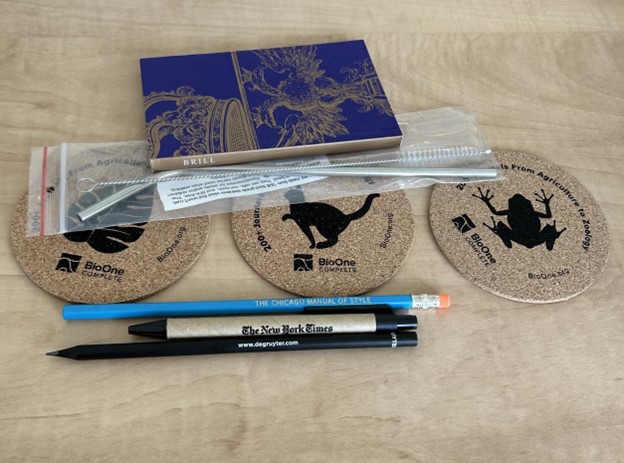Sustainable Swag Self-Evaluation Rubric for Vendors and Library Workers

straws, and notebooks that are reusable, made with less
plastic, or made with sustainable materials. Image
courtesy SustainRT Outreach Committee
Have you ever considered the environmental impact of swag? Whether you're attending a national conference or a local event, you're likely to see examples of pens, tote bags, and trinkets being distributed by libraries and vendors alike. While we all recognize the important role that swag can play in marketing, the American Library Association’s (ALA) Sustainability Round Table (SustainRT) Public Awareness and Advocacy Committee (PAAC) would like vendors and attendees to begin thinking more critically about the types of swag that are offered, what we pick up, and what we do with those items after the event ends.
In an effort to encourage more responsible and sustainable product sourcing, PAAC members Mandi Goodsett and Evan Meszaros created the Sustainable Swag Rubric to help vendors and library workers analyze their swag.
Explore the swag rubrics
The social, environmental, and economic impacts of swag can be evaluated with the rubric based on the following criteria:
- Extraction or transformation of raw materials
- Manufacturing
- Packaging and distribution
- Usefulness
- End of life
- Producer standards
The rubric was developed based on the life cycle analysis and is not exhaustive, but could be considered a guideline for swag evaluation. Each of the criteria can be evaluated as excellent, good, or poor. An example of “excellent” sustainable swag could be an item with limited or no plastic packaging that is highly useful and could be easily composted or ethically disposed of at the end of life. In addition, the item could be ethically sourced, made of recycled materials, or locally produced with low emissions in the production process. The item could meet existing standards or be produced by a minority group, such as women-, BIPOC-, indigenous-, or refugee-owned businesses. An example of “poor” sustainable swag could be an item that was produced where workers are exploited, materials are produced far away and production emissions are not considered, or extraction of raw materials is harmful to the ecosystem. In addition, these could be single-use items that are mostly plastic or packaged in plastic that is non-recyclable or biodegradable that will be discarded in landfills and do not meet environmental standards. Of course, part of the decision-making process should be whether swag is needed at all; sometimes experiences are both more environmentally-friendly and more impactful prizes than swag.
Examples of potentially strong vendor swag include, but are not limited to, virtual gift cards, bamboo lunch boxes, bamboo utensils, tote bags made from cotton or recycled material, small desk plants, plantable bookmarks, solar-powered chargers, etc.
This rubric was shared on the ALA Annual Conference Website for vendors to assess their swag, with examples of what could be considered “good” #SustainableSwag, as well as additional resources. Members of ALA have also been encouraged to evaluate vendor swag when attending conferences and to give a virtual shout-out on SustainRT social media accounts to vendors with sustainable swag using the hashtag #SustainableSwag. Members can submit examples of sustainable swag to this online form.
For library workers, consider using the swag rubric when choosing what to buy for library programs, events, and giveaways, and share it with your colleagues too. If sustainability-related projects like this one interest you, you might also consider joining ALA's Sustainability Round Table!
Additional resources
For further reading and resources, check out these WebJunction articles and a webinar with members of SustainRT
- Sustainability topic area on WebJunction
- Sustainable Libraries: Resources and Webinars for Climate Action, a collection of articles and webinars hosted in collaboration with the Sustainable Libraries Initiative
- Living Our Values Out Loud: Programs that Walk the Talk, webinar recording including an overview of the swag rubrics

